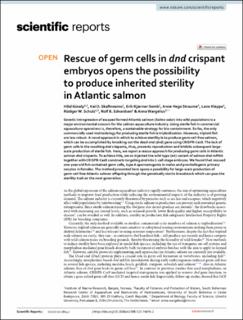| dc.description.abstract | Genetic introgression of escaped farmed Atlantic salmon (Salmo salar) into wild populations is a major environmental concern for the salmon aquaculture industry. Using sterile fish in commercial aquaculture operations is, therefore, a sustainable strategy for bio-containment. So far, the only commercially used methodology for producing sterile fish is triploidization. However, triploid fish are less robust. A novel approach in which to achieve sterility is to produce germ cell-free salmon, which can be accomplished by knocking out the dead-end (dnd) gene using CRISPR-Cas9. The lack of germ cells in the resulting dnd crispants, thus, prevents reproduction and inhibits subsequent large-scale production of sterile fish. Here, we report a rescue approach for producing germ cells in Atlantic salmon dnd crispants. To achieve this, we co-injected the wild-type (wt) variant of salmon dnd mRNA together with CRISPR-Cas9 constructs targeting dnd into 1-cell stage embryos. We found that rescued one-year-old fish contained germ cells, type A spermatogonia in males and previtellogenic primary oocytes in females. The method presented here opens a possibility for large-scale production of germ-cell free Atlantic salmon offspring through the genetically sterile broodstock which can pass the sterility trait on the next generation. | en_US |
